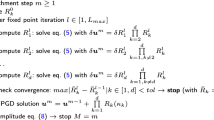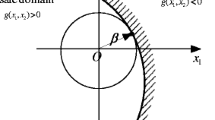Abstract
Monte Carlo simulation is a useful method for reliability analysis. But in Monte Carlo, a large number of simulations are required to assess small failure probabilities. Many methods, such as Importance sampling, have been proposed to reduce the computational time. In this paper, a new importance sampling Monte Carlo method is proposed that reduces the numbers of calculation of the limit state function. On the other hand, the proposed algorithm does not need the knowledge about the position of the design point or the shape of the limit state function. The key-idea of the proposed algorithm is that the mean of sampling density function is changed throughout the simulation. In fact, in random point generating process each point with lower absolute value of limit state function and nearer distance from space center is considered the mean of the sampling density function. Based on this, the centralization of the sampling will be on the important area.
Similar content being viewed by others
References
Bucher, C. G. (1988). “Adaptive sampling — An iterative fast Monte Carlo procedure.” Structural Safety, Vol. 5, No. 2, pp. 119–126.
Cao, H. D. and Wei, W. (2011). “Low-discrepancy sampling for structural reliability sensitivity analysis.” Structural Engineering and Mechanics, An Int’l. Journal, Vol. 38, No. 1, pp. 125–140.
Deng, L., Ghosn, M., and Shao, S. (2004). “Shredding genetic algorithm for reliability analysis of structural systems.” J. Struct. Safety, Vol. 27, No. 4, pp. 113–131.
Ditlevsen, O. and Madsen, H. O. (1996). Structural reliability methods, New York, Wiley.
Elegbede, C. (2005). “Structural reliability assessment based on particles swarm optimization.” J. Struct. Safety, Vol. 27, No. 2, pp. 171–186.
Frangopol, D. (1984). “Interactive reliability based structural optimization.” Comp. Struct, Vol. 19, No. 4, pp. 559–563.
Grooteman, F. (2008). “Adaptive radial-based importance sampling method for structural reliability.” Structural Safety, Vol. 30, No. 6, pp. 533–542.
Hammerley, J. M. and Handscomb, D. C. (1964). Monte carlo methods, John Wiley & Sons, New York, NY.
Harbitz, A. (1986). “An efficient sampling method for probability of failure calculation.” Struct Safety, Vol. 3, No. 2, pp. 109–115.
Hasofer, A. M. and Lind, N. C. (1974). “An exact and invariant first order reliability format.” Journal of Engg. Mech., ASCE, Vol. 100, No. 1, pp. 111–121.
Hwang, N., Reich, M., Ellingwood, B., and Shinozuka, M. (1986). Reliability assessment and probability based design of reinforced concrete containments and shear walls, Summary Report, NUREG, CR-3957, BNL-NUREG 51956, Upton, New York.
Iman, R. L. and Canover, W. J. (1980). “Small sampling sensitivity analysis techniques for computer models with an application to risk assessment.” Commun. Stat., Theory Methods, Vol. A9, No. 17, pp. 1749–1842.
Lu, Z.-H., Zhao, Y.-G., and Ang, A. H.-S. (2010). “Estimation of load and resistance factors based on the fourth Moment method.” Structural Engineering and Mechanics, An Int’l. Journal, Vol. 36, No. 1, pp. 19–36.
Madsen, H. O., Krenk, S., and Lind, N. C. (1986). Methods of structural safety, Englewood Cliffs, NJ, Prentice-Hall.
Maes, M. A., Breitung, K., and Dupuis, D. J. (1992). “Asymptotic importance sampling.” Structural Safety, Vol. 12, pp. 167–186.
Melchers, R. E. (1989). “Importance sampling in structural systems.” Structural Safety, Vol. 6, No. 1, pp. 3–10.
Melchers, R. E. (1990). “Search-based importance sampling.” Structural Safety, Vol. 9, No. 2, pp. 117–128.
NASA (1968). SP-8019 Buckling of thin-walled truncated-cones. NASA space vehicle design criteria (structures).
Papadrakakis, M. and Nikos Lagaros, D. (2002). “Reliability-based structural optimization using neural networks and Monte Carlo simulation.” Comput. Methods Appl. Mech. Engrg., Vol. 191, No. 32, pp. 3491–3507.
Rackwitz, R. (2001). “Reliability analysis — A review and some perspectives.” Structural Safety, Vol. 23, No. 4, pp. 365–395.
Rubinstein, R. Y. (1981). Simulation and the monte-carlo method, John Wiley & Sons, New York, NY.
Schuëller, G. I. and Stix, R. (1987). “A critical appraisal of methods to determine failure probabilities.” Structural Safety, Vol. 4, No. 4, pp. 293–309.
Shao, S. and Murotsu, Y. (1999). “Approach to failure mode analysis of large structures.” Probabilistic Eng. Mech., Vol. 14, Nos. 1–2, pp. 169–177.
Sung, H. H. (2011). “A study on safety assessment of cable-stayed bridges based on stochastic finite element analysis and reliability analysis.” KSCE Journal of Civil Engineering, Vol. 15, No. 2, pp. 305–315.
Yonezawa, M., Okuda, S., and Kobayashi, H. (2009). “Structural reliability estimation based on quasi ideal importance sampling simulation.” Structural Engineering and Mechanics, Vol. 32, No. 1, pp. 55–69.
Yonezawa, M., Okuda, S., and Park, Y.-T. (1998). “Adaptive sampling for reliability estimation of structure with multimode failure.” In Reliability and optimization of structural systems, Nowak, A. S. (ed.), Proc. of 8th IFIP WG7, Michigan, Book Crafters, Vol. 5, pp. 337–344.
Zhao, Y.-G. and Ono, T. (1999). “A general procedure for first/secondorder reliability method (FORM/SORM).” Structural Safety, Vol. 21, No. 2, pp. 95–112.
Zhao, Y.-G. and Ono, T. (2001). “Moment methods for structural reliability.” Structural Safety, Vol. 23, No. 1, pp. 47–75.
Zou, R., Lung, W. S., and Guo, H. C. (2002). “Neural network embedded Monte Carlo approach for water quality modeling under input information uncertainty.” KSCE Journal of Civil Engineering, Vol. 16, No. 2, pp. 135–142.
Author information
Authors and Affiliations
Corresponding author
Rights and permissions
About this article
Cite this article
Jahani, E., Shayanfar, M.A. & Barkhordari, M.A. A new adaptive importance sampling Monte Carlo method for structural reliability. KSCE J Civ Eng 17, 210–215 (2013). https://doi.org/10.1007/s12205-013-1779-6
Received:
Accepted:
Published:
Issue Date:
DOI: https://doi.org/10.1007/s12205-013-1779-6




